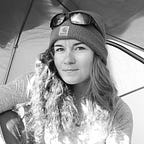License to Krill
To figure out how much whale food is in the water, marine scientists rely on sound waves.
Sound travels through water at five times the speed it travels through air.
This is helpful for scientists who want to know more about exactly what kind of organisms are in a particular area of water at a given time.
Take Andvord Bay for example. On a cold Sunday evening, multiple groups of humpback whales congregate in this calm body of water in the Antarctic Peninsula — they are most likely here to feed. To find out just how much food is in this area, the team turns to Chris Taylor, our underwater acoustics specialist.
“Air bubbles, gas bladders in fish, oil globules in plankton, the sea floor — anything that’s a different density than water will reflect sound,” Taylor says. “The key component is the ability to receive the echo from sound waves bouncing off that object.”
Enter our fancy fish finder — the calibrated, scientific split-beam echo-sounder. This three-part system transmits and receives sound underwater, reflecting off objects at different densities than the water itself. Here’s how it works: the transceiver (housed inside a pelican case on the ship) generates an electrical current that travels down a cable to a transducer in the water which translates that electrical energy into sound energy. The transducer is housed inside a rig we refer to as “the tow fish”.
As the name suggests, this large chunk of metal looks a bit like a giant yellow fish, and can lower into the water via steel cables and ride along next to the ship. As the tow fish travels through the water, it blasts out a short wave of sound energy, or a “ping”. When the ping hits something — like a patch of krill — it bounces back to the tow fish, which tells us exactly how far away the krill are. The transducer can do this two times a second. The pings it gathers produce a colorful map of data from the surface to the sea floor.
While half the whale team loads into zodiac boats full of tagging equipment, Chris Taylor stands on the back deck of the ship to help get the tow fish in the water.
“It’s just transmitting sound pulses and getting reflections from the water column,” he says. “There isn’t much in the water column except for krill and fish. It’s connected to a GPS so we know exactly where they are.
With the tow fish securely in the water, Taylor settles into the electronics lab where he can see what it’s capturing in real time. The unit also includes a GPS to inform us of the exact locations, while sonar tracks the depth of the patch. “This krill patch,” he says, pointing to a dark red blob amidst a vast spectrum of color, “is exactly one nautical mile long.”
But how do we know it’s patch of krill, and not a school of fish? At higher frequencies, krill has a louder echo, while fish produce a louder echo at lower frequencies. Taylor uses a 120 kilohertz (kHz) transducer as well as a 38 kHz transducer to differentiate between the two.
The goal is to paint a picture of the location of krill over large spatial scales — like an entire bay — to provide context for where the whales might feed.
“Are whales only occupying areas where there are large patches of krill? Is it easier for them to feed?” Taylor asks. “Where, why, and what are they doing?”
Two days later, having mapped over 50 nautical miles of Andvord Bay, Taylor can see there is more krill at the middle and end of the bay and less at the mouth of the bay.
The next step is to correlate this data with the data we get back from the tags.
Want to see more from the minke team in Antarctica? Check out our photos on Instagram and follow #insearchofminkes
